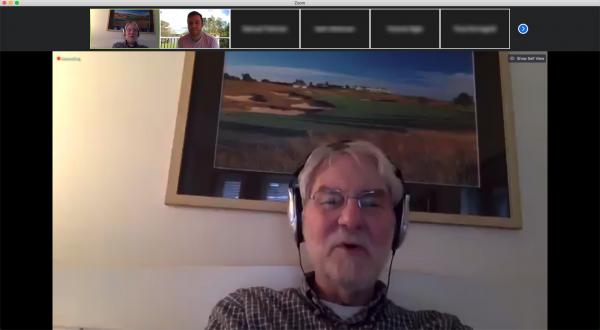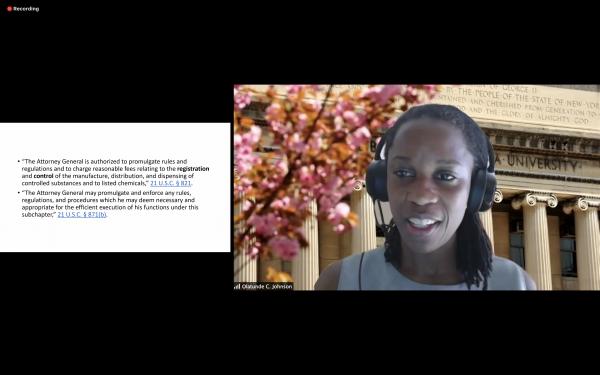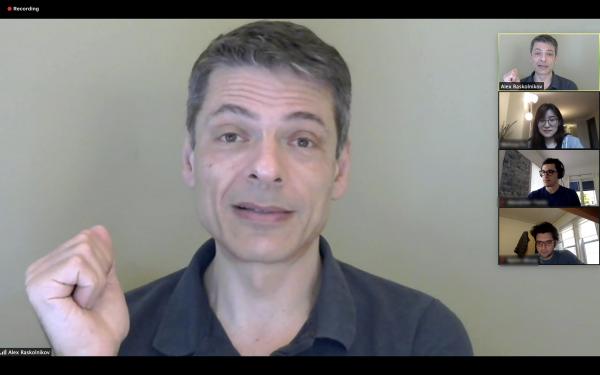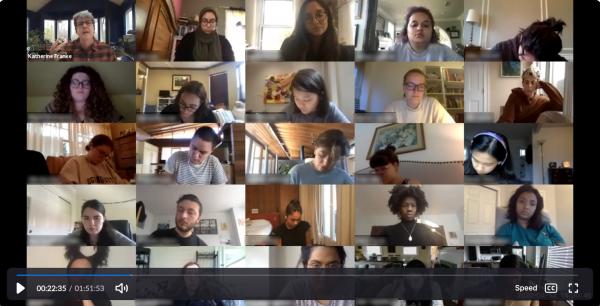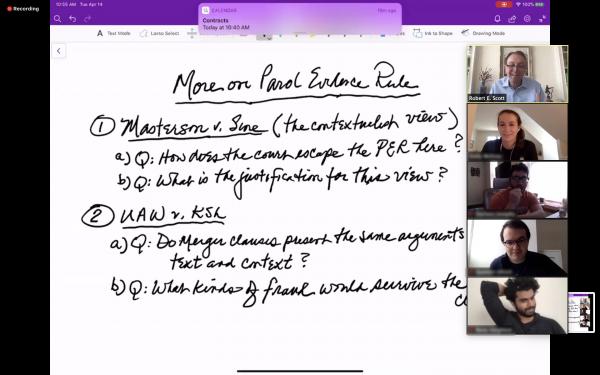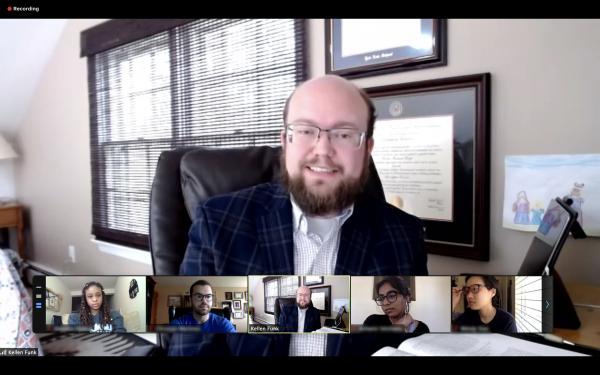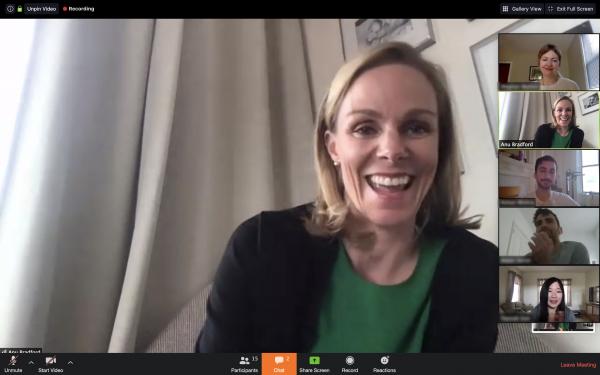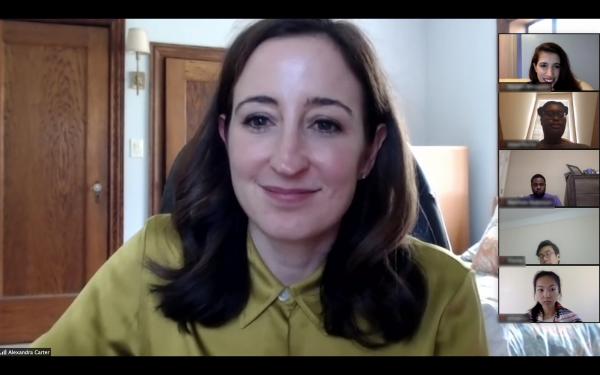Socratic Zooming: Faculty Weigh in on Teaching Remotely
Online instruction means working harder to keep everyone engaged, but faculty members are finding ways to do so.
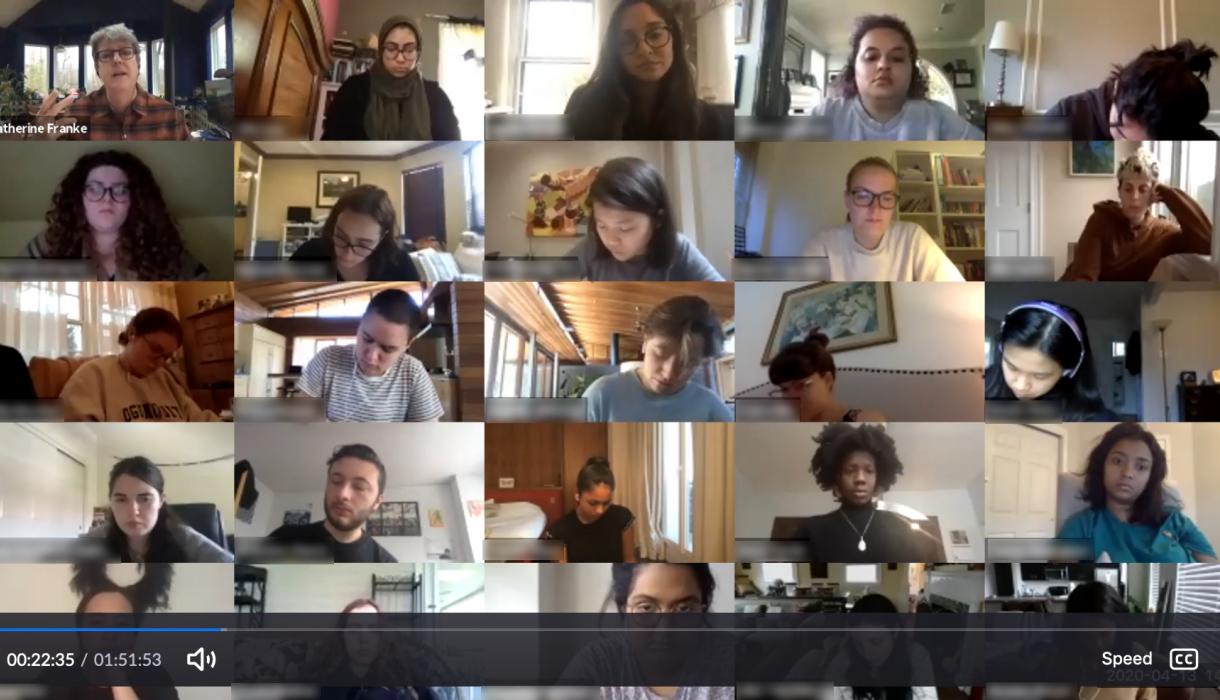
On March 11, when the World Health Organization declared the COVID-19 outbreak a pandemic, Columbia Law School transitioned its entire curriculum—more than 300 courses—into virtual classrooms. Students gathered online; law professors, regardless of their technical expertise, stepped up to the webcam to teach seminars, clinics, and lecture courses. We asked faculty members to reflect on what they are learning from the experience of teaching remotely. Can Zoom replace the classrooms of Jerome Greene Hall? Perhaps not exactly, but law professors say they have discovered interesting upsides to remote instruction.
Vincent Blasi
Corliss Lamont Professor of Civil Liberties
Teaching Torts
I am the antithesis of a techie, and in fact was terrified at the prospect of having to teach online. I’m finding teaching via Zoom unexpectedly congenial. My class sessions feel more genuinely Socratic than in a large classroom. By that I mean more like the two-person conversations of the original Socratic dialogs as reported by Plato. The back-and-forth exchanges feel more private even though both participants know that 80 or 90 other students are listening and able to join in. Despite the lack of physical presence, the interaction is more personal. There is less performance both on my part and the students’. Perhaps for that reason, I find that the analysis tends to be more open-ended and in that respect more probing. Students seem more relaxed in a productive way. They are not afraid to see where their thought leads. That’s true for me as well. I have been learning more in my Zoom classes than I usually do teaching in a 100-person classroom. I will be sorry when this ends.
Olatunde Johnson
Jerome B. Sherman Professor of Law
Teaching Legislation and Regulation
You have to teach differently to be effective remotely. I have found myself using more visual materials to hold students’ attention. I also use breakout rooms so that students can interact with each other in discussion groups. Some of these changes have been very good. I use more problems and hypotheticals than before. I have students prepare the problems before class and discuss them during our session. We spend less time on lecture and Socratic exchange and more time wrestling with the practical and policy challenges of applying doctrine.
We have brought issues related to the pandemic into our study of statutory interpretation and administrative law. This includes due process constraints on the quarantine, whether liquor stores and bike shops are “essential” under the New York State on PAUSE executive order, and the president’s power to control oversight over the pandemic bailout fund.
Alex Raskolnikov
Wilbur H. Friedman Professor of Tax Law
Teaching Federal Income Taxation
The biggest challenge—and drawback—of Zoom for me is that I can’t read the room as easily. This is not a big deal for a faculty workshop or committee meeting; I know that everyone understands what I am saying. They may agree or disagree or have some specific questions, but no one is confused. In my class people occasionally are confused, and I can see it when I see their faces. Even when they don’t ask questions, I just see it. And now I can’t.
Oh, and of course, it’s hard to joke around into a silent camera. :-(
Katherine Franke
James L. Dohr Professor of Law
Teaching Gender Justice (Columbia College)
I’ve always delighted in the intimacy of classroom teaching, the rapport you build with the students in the class—when they laugh at my jokes and when I can see who is really engaged with the class discussion and who seems to be struggling. For this reason, I dreaded moving my teaching to Zoom. Oddly enough, in some ways, I’ve found Zoom classes more intimate than classroom teaching. When students talk I see their faces up close, not 30 feet away in the classroom. And I’ve made it a priority to check in with all of them every week. In these check-ins, I have learned so much more about them than I would have in a regular class. Many of them are struggling. They are so used to thriving in an academic culture, and to have that culture so fundamentally altered deprives them of the oxygen they depend on to flourish. For my student who moved back to Beijing, it’s 2 a.m. when our class starts. She watches the recording the next day and we have weekly meetings to talk about the issues in the class.
I’ve adjusted my teaching to have two or three students co-teach each session with me. They’ve found great videos and other media to use to break up the “heads in boxes,” and the discussion is much more dynamic this way. I’ve also been able to bring in amazing guest speakers to join the class for a half-hour or so—something that would have been impossible to do with an in-person class.
Robert Scott
Alfred McCormack Professor of Law
Teaching Contracts
I am doing the best that I can, and the students have been very well prepared and admirably engaged in learning even more about contracts (law and theory) than they had been before spring break. But I fear that I am not as good in this format as in the classroom. I tend to feed off of the energy and enthusiasm of the class, and since my practice is to walk and talk and ask questions as I move about the class, trying to do that while sitting still has been a challenge.
What the classroom gives you is the reaction of the class as a whole both to me and to their fellow students as we try to advance the discussion. Moreover, I simply miss seeing all their faces. I have been trying to call on eight or nine students at a time so that we can engage together, but bringing in the remaining 80 students at the same time via Zoom has thus far proven daunting.
Kellen Funk
Associate Professor of Law
Teaching Federal Courts
The biggest difficulty is the range of situations my students are facing. Not all have quality access to the technology needed for synchronous classes, and, of course some are very burdened by care needs for family members working in health services or otherwise affected by the spread of the virus. One benefit of moving online is the ability to bring up a common text on all students’ screens and walk through it line by line in a way that’s not always possible in a cavernous lecture hall. The drawback is that it is much more difficult to know whether I need to slow down or speed up my explanations and take questions.
Anu Bradford
Henry L. Moses Professor of Law and International Organization
Teaching Seminar in International Economic Migration
I was initially concerned about moving my seminar to Zoom given the importance of having an interactive dialogue where the students are expected to build a robust and lively conversation in the course of each class meeting. This calls for a very honest and constructive exchange of views on a set of diverse—and at times, quite provocative —readings. However, the students have been amazing in their engagement and focus through Zoom. The gallery view is terrific as everyone in a small seminar can see one another the entire time. While I miss seeing everyone in person, I have been very proud of the way the students have adjusted to the new world!
Alexandra Carter
Clinical Professor of Law
Teaching Mediation Clinic
I worked with my Advanced Mediation Clinic students on a presentation for the Mediation Clinic (which we also gave to hundreds of other lawyers, mediators, and judges from the New York City area last month) on successful virtual conversations. Together, we found through research and experience that shorter sessions work better both in terms of allowing people to manage work-life obligations and also in terms of maintaining stamina.
I don’t think Zoom will fully replace in-person mediations, but I expect a significant increase in the number of mediations done on Zoom in the future. So this is great practice for our clinic!
Jody Kraus
Patricia D. and R. Paul Yetter Professor of Law
Teaching American Contract Law
I enjoy the direct one-on-one feel of the Socratic method on Zoom with the student I’ve called on, but I’d like to be able to make eye contact with all of the other students at the same time.
Teaching on Zoom is far less time-consuming than teaching in person because it avoids the need for commuting to a physical classroom. It’s hard to avoid the thought that, whatever Zoom’s weaknesses, they are more than compensated for by the incalculable time and energy cost it saves. Of course, the benefits of in-person contact are also incalculable. These are the trade-offs we’re all experiencing.
